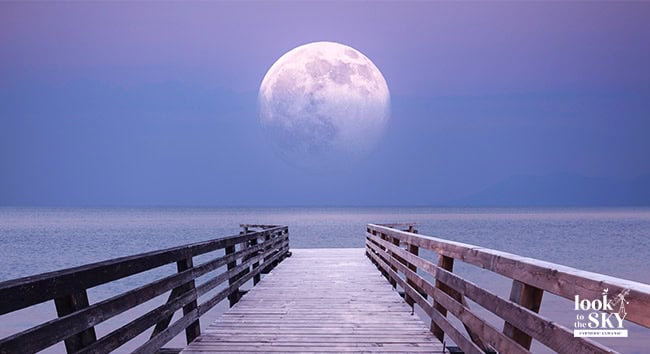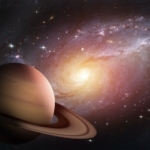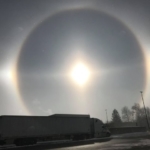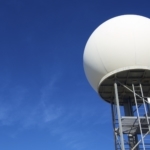July night sky highlights include the Parade of Planets 2024, the Full Buck Moon, and many dazzling arrangements of bright planets and the Moon. Plus, we welcome Venus back to the night sky where she will hang as a recognizable “star” through the end of summer. Farmers’ Almanac expert astronomical reports have been in continuous publication since 1818. If you ever have any questions or would like something explained a bit more, let us know in the comments!
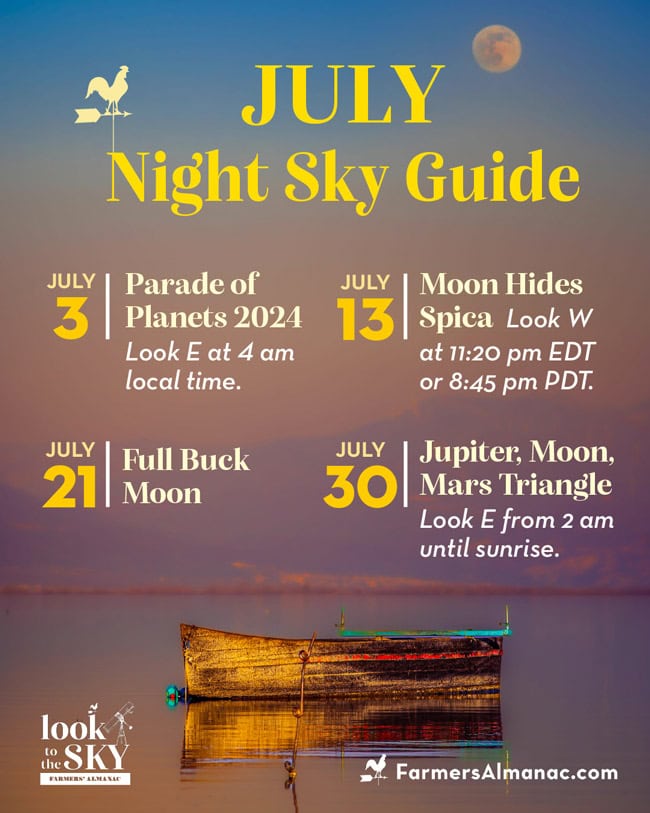
July Night Sky Guide
All times and positions are listed in Eastern time, 40 degrees north of the equator—unless otherwise specified. If you see the terms sunset, midnight, sunrise or local time, this is true no matter where you are located (no need to add or subtract for your time zone).
Look for the telescope emoji – 🔭 – which means that we recommend binoculars or telescopes. Psst … Find fun astronomy gear and more in our Starry Nights Gift Guide.
July 1 – Mars and the Moon
Look to the eastern horizon approximately two hours before sunrise. Mars can be found about five degrees to the lower left of the waning crescent Moon.
Over the course of the month, Mars, floats steadily against the background stars, shifting from Aries the Ram into Taurus the Bull.
⭐ 🔭 July 3 – Parade of Planets 2024
Five planets, Pluto, and the Moon will march in a row early this morning. Look east and to the south at approximately 4 a.m. local time. (The only two planets missing will be Mercury and Venus, which are on the other side of the Sun.) Learn more.
July 5 – Aphelion
Earth reaches aphelion (its furthest point from the Sun) at 1:06 a.m. EDT. At that moment, the Sun will be 94,510,539 miles away. That’s more than three percent farther than when the Earth was at perihelion (its closest point to the Sun) on January 2.
Does it seem strange that the weather is hotter when the Sun is further away? Learn more about this phenomenon.
Later this day, the New Moon occurs at 6:57 p.m. EDT.
🔭 July 7 – Crescent Moon and Mercury
Up for a challenge? Look low near the west-northwest horizon about one half hour after sunset, using binoculars, scan low near the west-northwest horizon to sight a narrow waxing crescent Moon and situated about 2½° directly below it will be the planet Mercury, shining at magnitude -0.1.
July 8 – Spot Sagittarius
On these early summer evenings at around 10 p.m., look low in the southeast for the classical Archer, Sagittarius. Traditionally a centaur (half man, half horse), it’s one of two such creatures in the sky. The other is Centaurus, a large, complex star pattern best viewed in the spring from far-southern localities. Although tracing out an Archer-Centaur among Sagittarius’ stars does require some imagination, visualizing it as a Teapot is quite easy.
More than 50 years ago, astronomer George Lovi (1939-1993) pointed out that we could augment our tea service with a teaspoon and lemon as well!
The teaspoon comprises stars in northern Sagittarius, while the lemon is an alternate rendition of the faint constellation Corona Australis, the southern crown. Originally, this group represented a crown of leaves sometimes worn by the ancients on ceremonial occasions.
July 9 – Jupiter and Aldebaran
Jupiter passes less than five degrees to the upper left of the orange 1st-magnitude star, Aldebaran, the “angry eye of the Bull,” Taurus.
⭐ July 13 – Moon Hides Spica
The first quarter Moon occurs at 6:49 p.m. EDT. Later on, look west (at 11:20 pm EDT or 8:45 pm PDT) to glimpse the Moon occulting (hiding) the 1st-magnitude star Spica, the brightest star in the constellation Virgo.
Spica will disappear along the Moon’s dark edge, and reappear about an hour later from the Moon’s bright side.
Note: In the East, only the star’s disappearance will be visible (not its reemergence) as the Moon will set before the star reappears. Here is a schedule of over 700 locations (listed in Greenwich Time).
Any questions? Contact [email protected]
July 15 – Mars and Uranus
If you train a pair of binoculars on Mars early this morning, you may notice a dim greenish-blue “star” located about ½° to its upper left. That will be the planet Uranus, which is 1.87 billion miles from Earth.
July 16 – Venus Returns to Night Sky!
Look west-northwest within one hour after sunset to spot Venus hovering low on the horizon. We recommend binoculars or a telescope, but please wait until the Sun has disappeared below the horizon.
July 20 — Jupiter, Mars, and the Pleiades
Look east before midnight to see Jupiter, Mars, and the Pleiades shining brightly together. As a bonus, look southwest to see a nearly full Moon.
⭐ July 21 – Full Buck Moon
The Full Moon Buck Moon reaches peak illumination at 6:17 a.m. EDT.
July 24 – Moon Kisses Saturn
Beginning at around 11 p.m. tonight, look low on the eastern horizon to see the waning gibbous Moon rising with Saturn about five degrees to the upper right.
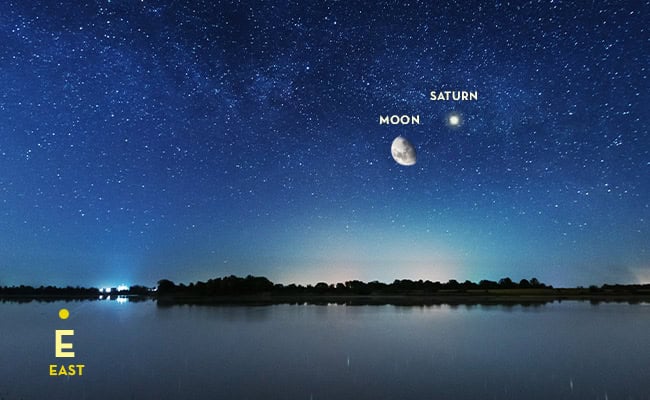
Saturn rises in the east-southeast as late as midnight daylight saving time at the start of July, but by the end of the month it’s coming up near the end of evening twilight. The ring system of golden Saturn is starting to widen its tilt to us for the late summer and early fall.
July 27 – Last Quarter Moon
The last quarter Moon occurs at 10:52 p.m. EDT.
July 28 – Delta Aquarid Meteor Shower
The last quarter Moon will hamper observations of this year’s Delta Aquarid Meteor Shower this morning, when maximum activity is expected. But because the duration of the shower is about 20 days, some Delta Aquarids may be seen by after-midnight watchers for several days later.
In past years, under good conditions a single observer could expect up to 20 shower members per hour, many as bright as magnitude +2 or +3 and darting from the southern sky.
Since Aquarius crosses the meridian at around 2:30 a.m., the best time to watch for these meteors will be between midnight and dawn.
⭐ July 30 – Jupiter, Moon, Mars Triangle
Look east from 2 a.m. until sunrise. Mars will form a broad right-triangle with a waning crescent Moon to its upper left and Jupiter, well to its lower left. (On the following morning, July 31, the Moon will appear to the lower left of Jupiter.)
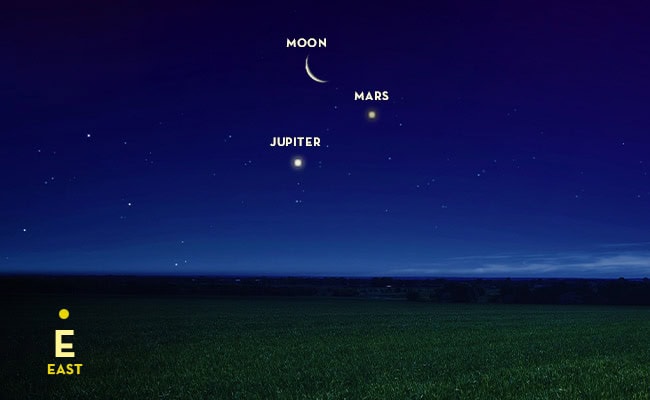
Join The Discussion
Which sky event are you looking forward to in the July sky?
Do you have any questions or suggestions for our sky guide?
Share with your community here in the comments below!

Joe Rao
Joe Rao is an esteemed astronomer who writes for Space.com, Sky & Telescope, and Natural History Magazine. Mr. Rao is a regular contributor to the Farmers' Almanacand serves as an associate lecturer for the Hayden Planetarium in New York City.

